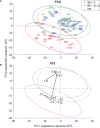Metabolic trajectories of diabetic ketoacidosis onset described by breath analysis
- PMID: 38752172
- PMCID: PMC11094216
- DOI: 10.3389/fendo.2024.1360989
Metabolic trajectories of diabetic ketoacidosis onset described by breath analysis
Abstract
Purpose: This feasibility study aimed to investigate the use of exhaled breath analysis to capture and quantify relative changes of metabolites during resolution of acute diabetic ketoacidosis under insulin and rehydration therapy.
Methods: Breath analysis was conducted on 30 patients of which 5 with DKA. They inflated Nalophan bags, and their metabolic content was subsequently interrogated by secondary electrospray ionization high-resolution mass spectrometry (SESI-HRMS).
Results: SESI-HRMS analysis showed that acetone, pyruvate, and acetoacetate, which are well known to be altered in DKA, were readily detectable in breath of participants with DKA. In addition, a total of 665 mass spectral features were found to significantly correlate with base excess and prompt metabolic trajectories toward an in-control state as they progress toward homeostasis.
Conclusion: This study provides proof-of-principle for using exhaled breath analysis in a real ICU setting for DKA monitoring. This non-invasive new technology provides new insights and a more comprehensive overview of the effect of insulin and rehydration during DKA treatment.
Keywords: ICU; breath analysis; diabetic ketoacidosis; mass spectrometry; metabolomics.
Copyright © 2024 Awchi, Singh, Brenner, Burckhardt, Hess, Zeng, Datta, Frey, Zumsteg, Szinnai and Sinues.
Conflict of interest statement
PS is co-founder of Deep Breath Intelligence AG Switzerland, which develops breath-based diagnostic tools. KDS and JZ are consultants for Deep Breath Intelligence AG Switzerland. The University Children’s Hospital Basel is a shareholder of Deep Breath Intelligence AG Switzerland. The remaining authors declare that the research was conducted in the absence of any commercial or financial relationships that could be constructed as a potential conflict of interest.
Figures




Similar articles
-
Standardization procedures for real-time breath analysis by secondary electrospray ionization high-resolution mass spectrometry.Anal Bioanal Chem. 2019 Jul;411(19):4883-4898. doi: 10.1007/s00216-019-01764-8. Epub 2019 Apr 15. Anal Bioanal Chem. 2019. PMID: 30989265 Free PMC article.
-
Real-time breath analysis of exhaled compounds upon peppermint oil ingestion by secondary electrospray ionization-high resolution mass spectrometry: technical aspects.J Breath Res. 2020 Jul 21;14(4):046001. doi: 10.1088/1752-7163/ab9f8b. J Breath Res. 2020. PMID: 32691749
-
Preservation of exhaled breath samples for analysis by off-line SESI-HRMS: proof-of-concept study.J Breath Res. 2023 Dec 13;18(1). doi: 10.1088/1752-7163/ad10e1. J Breath Res. 2023. PMID: 38029449
-
Breath Analysis by Secondary Electro-Spray Ionization - Mass Spectrometry to Interrogate Biologically Significant Metabolites Non-Invasively.Crit Rev Anal Chem. 2023;53(4):825-837. doi: 10.1080/10408347.2021.1981226. Epub 2021 Oct 3. Crit Rev Anal Chem. 2023. PMID: 34605329 Review.
-
Direct mass spectrometry analysis of exhaled human breath in real-time.Mass Spectrom Rev. 2025 Jan-Feb;44(1):43-61. doi: 10.1002/mas.21855. Epub 2023 Aug 10. Mass Spectrom Rev. 2025. PMID: 37565588 Review.
Cited by
-
Advancements in Ambient Ionisation Mass Spectrometry in 2024: An Annual Review.Anal Sci Adv. 2025 Mar 22;6(1):e70007. doi: 10.1002/ansa.70007. eCollection 2025 Jun. Anal Sci Adv. 2025. PMID: 40123829 Free PMC article. Review.
-
Breath Analysis of Propofol and Associated Metabolic Signatures: A Pilot Study Using Secondary Electrospray Ionization-High-resolution Mass Spectrometry.Anesthesiology. 2025 Aug 1;143(2):345-356. doi: 10.1097/ALN.0000000000005531. Epub 2025 Apr 21. Anesthesiology. 2025. PMID: 40258137 Free PMC article.
References
MeSH terms
LinkOut - more resources
Full Text Sources
Medical

